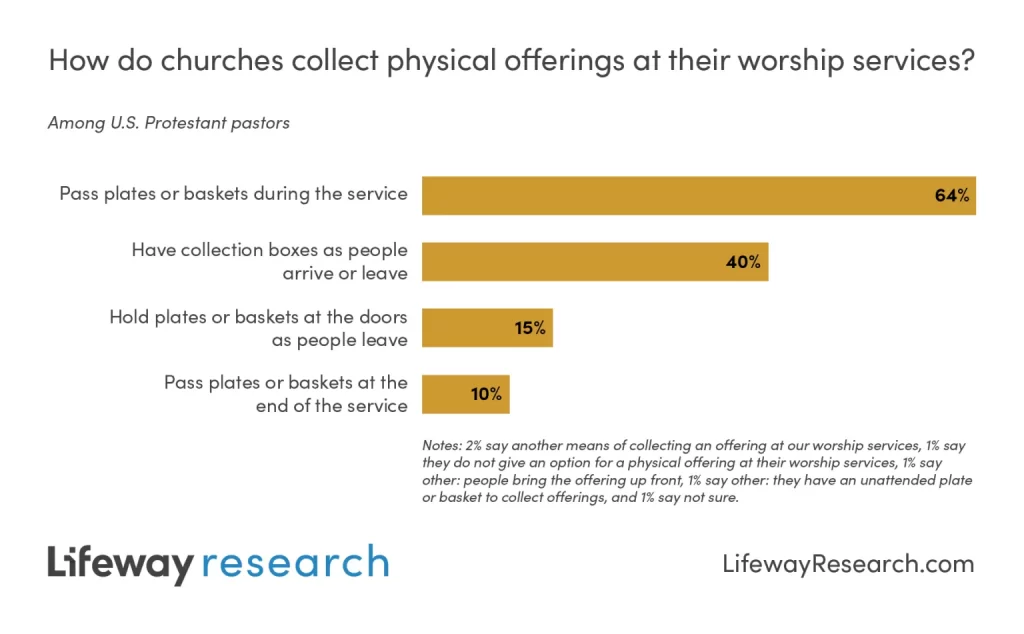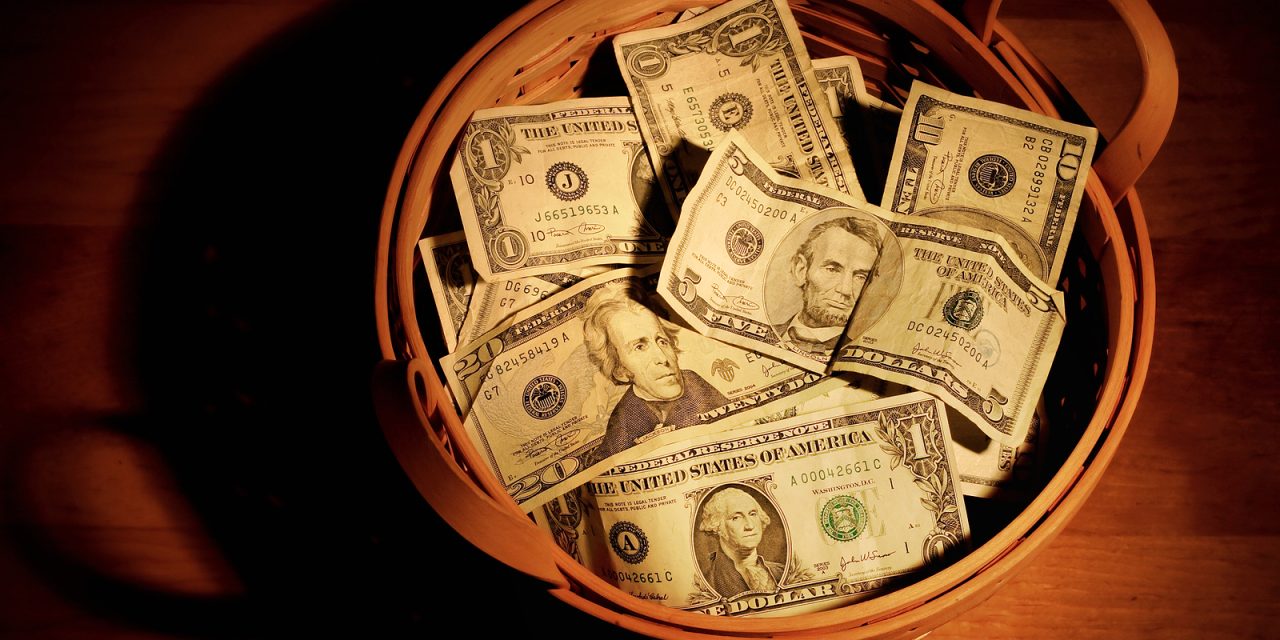This article was originally written by Aaron Earls and published to Lifeway Research.
When it comes to collecting offerings, most churches pass a plate, but they may also have a basket waiting for you as you walk out the door.
According to a Lifeway Research study of U.S. Protestant pastors, almost 3 in 4 say their congregation collects physical offerings by passing something around at the worship service. Close to half of pastors also report having ways to give as attendees arrive or leave. Some pastors say their congregations use more than one method.
“While many churches offer digital giving options, only 1% of churches say they don’t provide an opportunity to give an offering in person at their worship services,” said Scott McConnell, executive director of Lifeway Research. “The variety of methods for taking the collection reflects the wide variety of styles when it comes to practicing any element of worship.”

Courtesy of Lifeway.
Pass the Plate
Around 2 in 3 pastors (64%) say their churches pass plates or baskets during the service, the most popular method of collecting offerings overall. Those at normative-sized congregations, 50-99 attendees in worship services, are more likely than those at larger churches, 250 or more, to prefer this way (68% v. 56%).
Additionally, mainline pastors are more likely than evangelical pastors to collect offerings like this (74% v. 60%). African American pastors are more likely to pass a plate than their white counterparts (76% v. 63%).
Denominationally, Lutheran (77%) and Methodist (77%) pastors are more likely than Presbyterian/Reformed (65%), Baptist (64%), Pentecostal (61%), Restorationist movement (43%) or non-denominational pastors (36%) to pass a plate during the service.
One in 10 U.S. Protestant pastors (10%) pass plates or baskets at the end of the service. That method is more common among Baptists (15%) than Presbyterian/Reformed (7%) or Lutheran pastors (6%). The smallest congregations, those with fewer than 50 in attendance, are among the least likely to collect offerings this way (6%).
“If reluctance to pass the plate relates to the time it takes or the volunteers required, it’s not surprising smaller churches don’t see a problem,” McConnell said. “It’s also not surprising churches in liturgical traditions continue to pass the plate for an offering, as it is one of the ways an individual can respond to the Good News heard.”
Place a Box
The second most popular offering collection method is having collection boxes as people arrive or leave. Two in 5 U.S. Protestant pastors (40%) say their churches use such boxes.
Collection boxes are more common with evangelical pastors compared to mainline ones (45% v. 30%). Pastors younger than 45 years old (46%) and those at churches in the West (48%) are also among the most likely to prefer this method.
Non-denominational pastors (59%) are more likely than Baptists (43%), Pentecostals (41%), Presbyterian/Reformed (40%), Lutherans (32%) or Methodists (23%) to station a collection box for offerings.
Boxes set up for people arriving and leaving are also more common among larger churches. Pastors at congregations with 250 or more attendees (61%) and 100 to 249 (45%) are more likely to use collection boxes than those at churches with 50 to 99 (37%) and less than 50 (33%).
Around 1 in 7 Protestant pastors (15%) say they hold plates or baskets at the doors as people leave. Those younger than 45 (20%) are among the most likely to use this method. Churches with 250 or more (25%) and 100 to 249 (20%) in attendance are more likely to do so than those with 50 to 99 (11%) and fewer than 50 (12%).
“Collection boxes can’t see if you give or not,” said McConnell. “While some churches use the boxes in addition to other methods to make sure everyone has the chance to give, others use them exclusively to minimize guilt or pressure to give.”
Other Methods
Few churches note other means of physically collecting offerings. Just 2% say they have another means of collecting offerings at their worship services. Additionally, 1% selected “other” and said people bring their contributions up to the front, and 1% selected “other” and said they have an unattended plate or basket to collect offerings. One percent of pastors aren’t sure how their churches collect offerings.
For 1% of U.S. Protestant pastors, their churches do not give an option for a physical offering at their worship services. This is appropriately rare because most churchgoers still physically give when they attend church.
A 2022 Lifeway Research study of Protestant churchgoers found that digital giving was increasing, but most still gave the old-fashioned way. Around 3 in 5 churchgoers who give to their churches (62%) say they didn’t use any electronic methods, while 35% say they use at least one.
The most popular ways for churchgoers to give to their churches are through cash (53%) or a check (30%) at church. Fewer give electronically through the church website (23%), the bank (14%), by automation (8%), a church app (7%) or via text (2%). Additionally, 9% say they give by writing a check and sending it in the mail.
“Clearly, almost every church wants to provide an opportunity for in-person worshipers to give, either as an element of worship or while they are in the building,” said McConnell. “While more of the total dollars a church receives may be through digital giving today, ushers don’t charge a fee for collecting in person.”
For more information, view the complete report.



